Counter-Pressing
This session is focused on our ability to counter-press. This is an essential behaviour in our game model and it’s independent of formations. We have some element of counter-pressing in almost everything we do on the pitch.
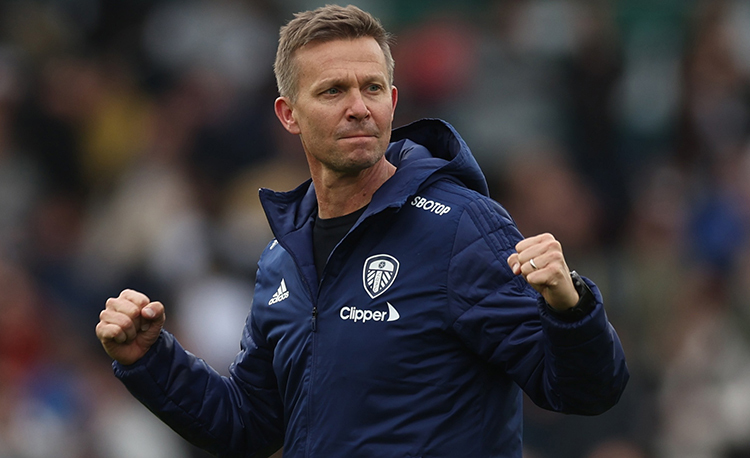
| Area | Up to two thirds of pitch |
| Equipment | Ball, bibs, cones, 2 full size goals |
| No. of Players | Up to 19 players + 2 goalkeepers |
| Session Time | Rondo 8v3: 15mins Counter-pressing 11v8: 20 mins Counter-pressing 11v10: 20 mins |
This session is focused on our ability to counter-press. This is an essential behaviour in our game model and it is independent of formations. We have some element of counter-pressing in almost everything we do on the pitch.
The reaction and hunger to win the ball immediately after we have lost possession is paramount to our idea of commanding the game. It is the reason that we include it with every element of training. In this manner, no doubt, it becomes a big part of our identity at Leeds United.
As mentioned, the behaviours are very important – however, the correct tactical positioning of our team is also essential. For this tactical theme we use the vocabulary term of “the net”. We create the visual of the net by drawing triangles between our players so they can envision their distances from each other on the pitch.
Ideally, we like our players to be distanced about 10-15 yards from each other at all times. We believe that is enough distance to manipulate the ball, our movement, and the opponent to create advantages in possession. However, more importantly, we believe it is the ideal spacing for counter-pressing when we lose the ball. If we are too compact, it is difficult to unbalance the opponent with the ball, and if we are too expansive, it is difficult to attack the ball once it has been lost.
This training session, like many we have, starts in smaller spaces to work on the behaviours of counter-pressing and progresses to bigger spaces where we incorporate more tactical comprehensions. The methodology is to enforce the technical aspects and reactions of counter-pressing and then to apply them to the tactical outlook.
“The reaction and hunger to win the ball immediately after we have lost possession is paramount to our idea of commanding the game”
RONDO 8v3
We have over one hundred rondos that emphasise counter-pressing. Here is one that is a favourite of mine, partially because it does not require a lot of loading and it precisely emphasises the behaviours.
We set up a playing area of 12x10 yards. We’re using 11 outfield players split into a red passing team of eight and a blue pressing team of three.
Play starts and restarts with the coach serving a ball into the red possession team, who proceed to pass it between themselves. The three blues try to win the ball by pressing from the centre of the playing area with the object of winning it and knocking it out of the grid. However, the three blues must take a minimum of two touches before being able to clear the ball or they remain in the middle, as shown [1a]. This is to allow the reds time to counter-press.
[1a]
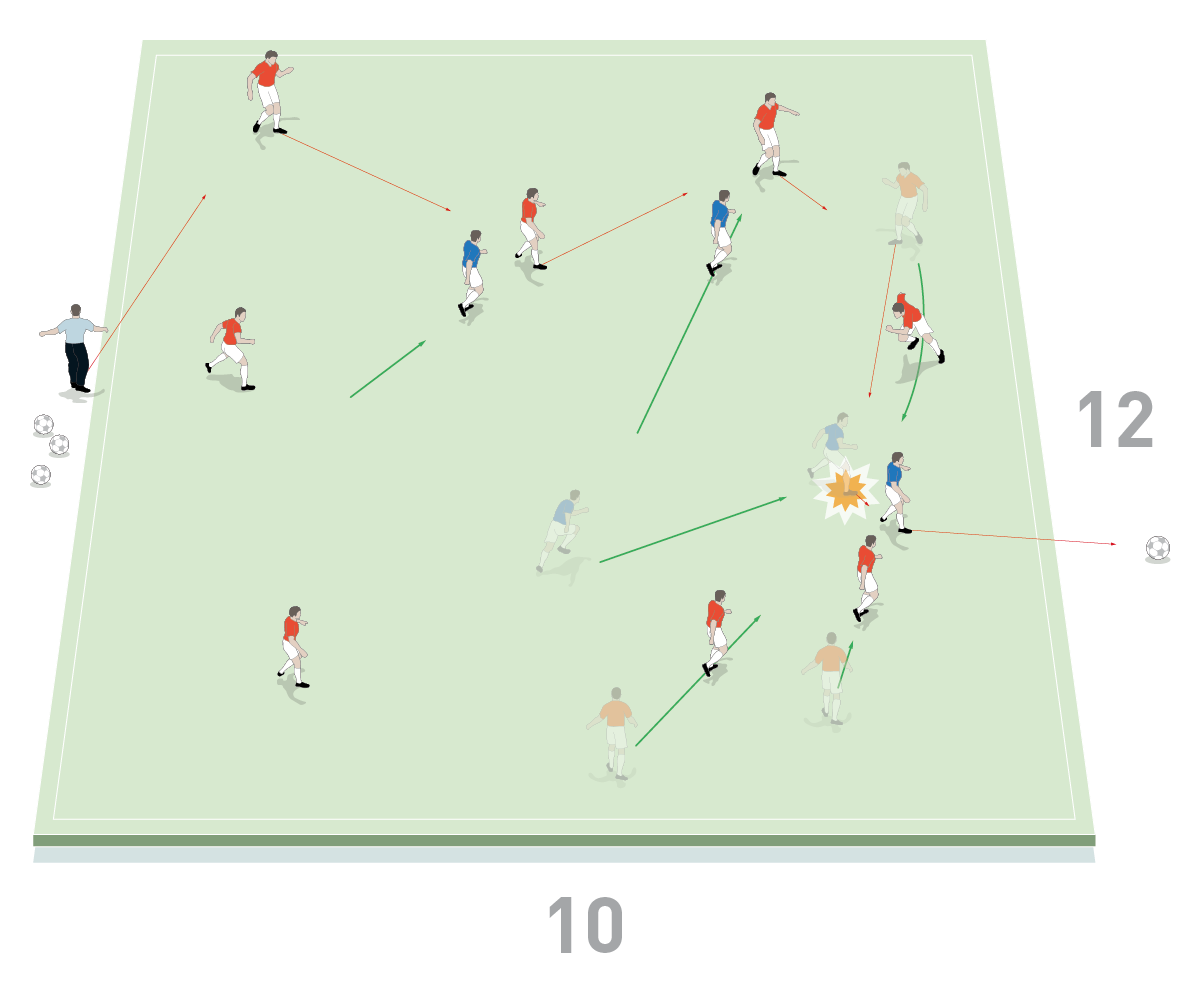
- Play starts and restarts with the coach serving a ball into the red possession team
- The three blues press from the centre and try to clear the ball out of the grid if they can
- The pressers must have a minimum of two touches on winning the ball before being able to clear it or they remain in the middle
[1b]

- Play always restarts with a ball from the coach to the red possession team
- When losing the ball, the reds should react immediately and try to win it back by counter-pressing
- If the three blue pressers win possession they must decide whether they can clear the ball or pass it. If they string three passes together, they must switch roles with the last three red players to touch the ball
When losing the ball, the reds should react immediately and try to win it back and initiate and retain possession once again, as shown [1b].
If the three blue pressing players win possession they must decide whether they can clear the ball or pass it. If they are able to string three consecutive passes together between all three of them after winning possession, they should switch roles with the last three red players to touch the ball before possession was lost.
“When losing the ball, the reds should react immediately and try to win it back and initiate and retain possession once again”
COUNTER-PRESSING 11v8
We set up a playing area of 70x55 yards as shown, with a full size goal at each end. We’re using 17 outfield players and two goalkeepers, split into a blue pressing team of eight set up in a GK-3-1-3 formation and a red possession team of 11 set up in a GK-4-2-3-1 formation.
Play always starts with a pass out from the red team’s goalkeeper and they build-up from the back under pressure from the blues, who can press as soon as the first pass from the goalkeeper has been played.
If the reds string eight consecutive passes together, they are free to attack the opposition’s goal but until then they are only allowed to keep possession.
If the blues win the ball, they are free to attack the opposition’s goal as well, as shown [2a].
[2a]
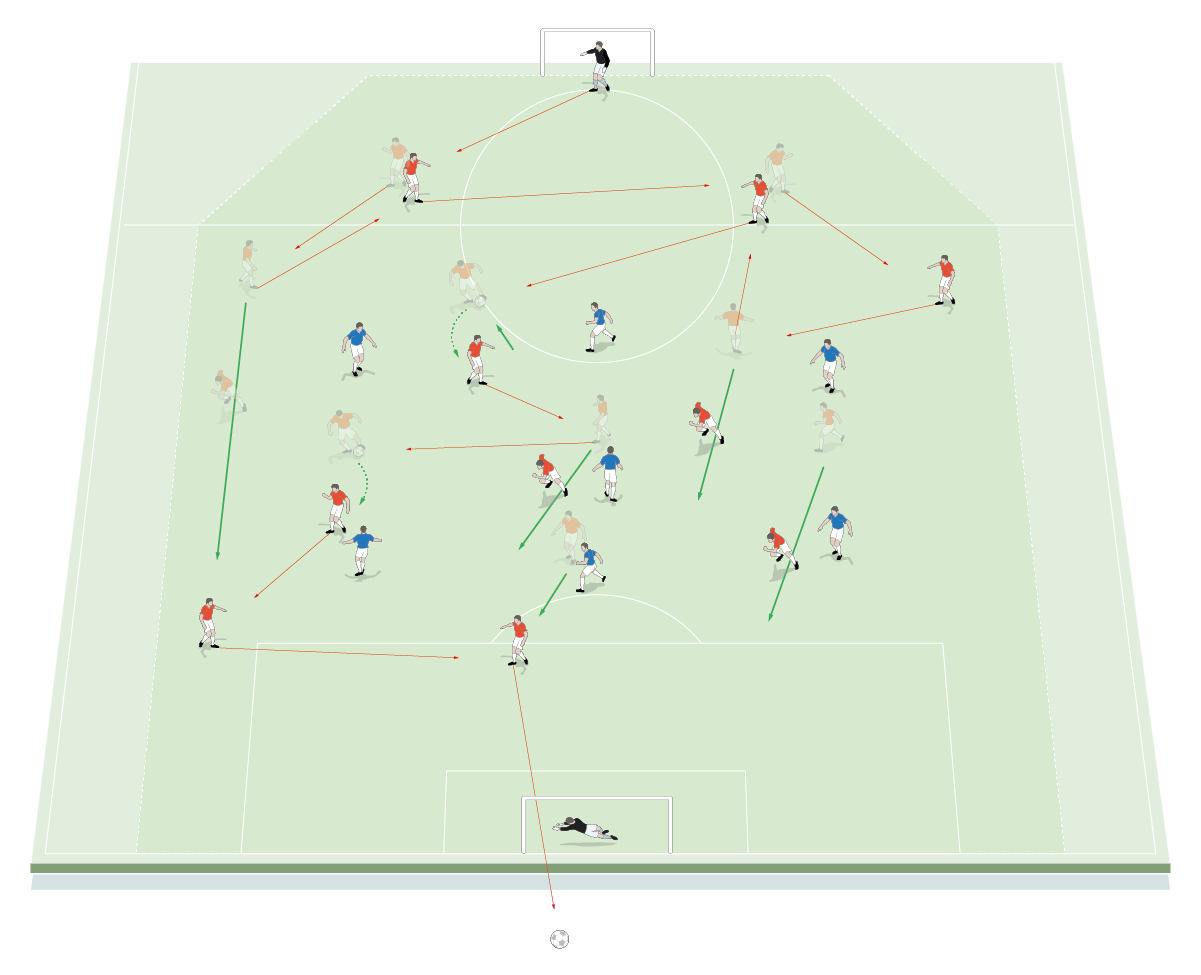
- Play starts with a pass out from the red team’s goalkeeper and the reds build-up from the back
- The blues can press as soon as the first pass from the goalkeeper has been played
- The reds must make eight consecutive passes before they are free to attack the opposition goal
“If the reds string eight consecutive passes together, they are free to attack the opposition goal”
If the reds lose the ball, they must counter-press immediately from all directions and try to win the ball back within five seconds – this is the most important part of the activity. Once they win the ball back, they no longer have a pass restriction and are free to attack the opposition goal, as shown [2b].
“The reds must counter-press immediately and try to win the ball back within five seconds”
[2b]
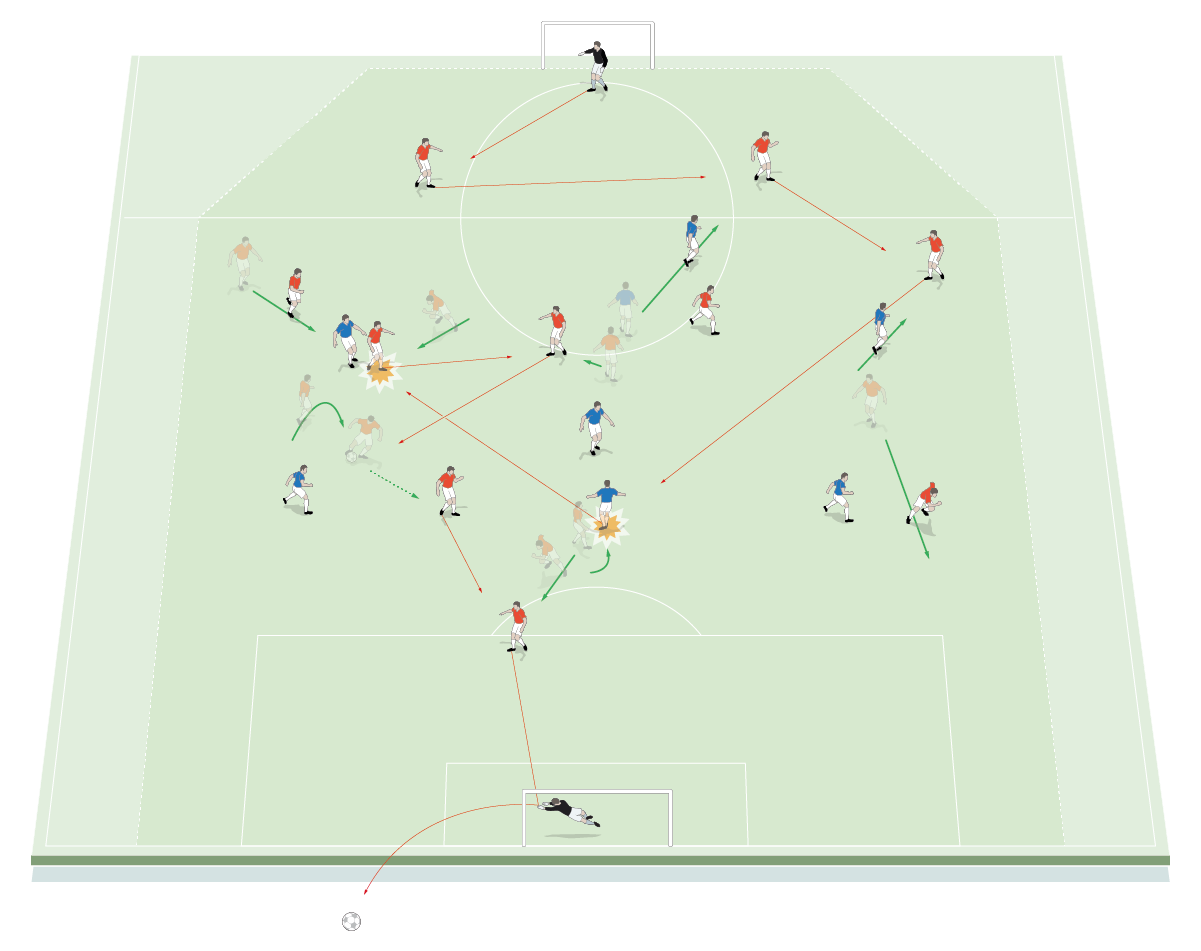
- Play always restarts from the red team’s goalkeeper
- If the blues win the ball, they are free to attack the opposition goal
- If the reds lose possession, they must counter-press immediately from all directions and try to win the ball back within five seconds
- Once the reds win the ball back through counter-pressing, they no longer have a pass restriction and are free to attack the opposition goal
COUNTER-PRESSING 11v10
[3]
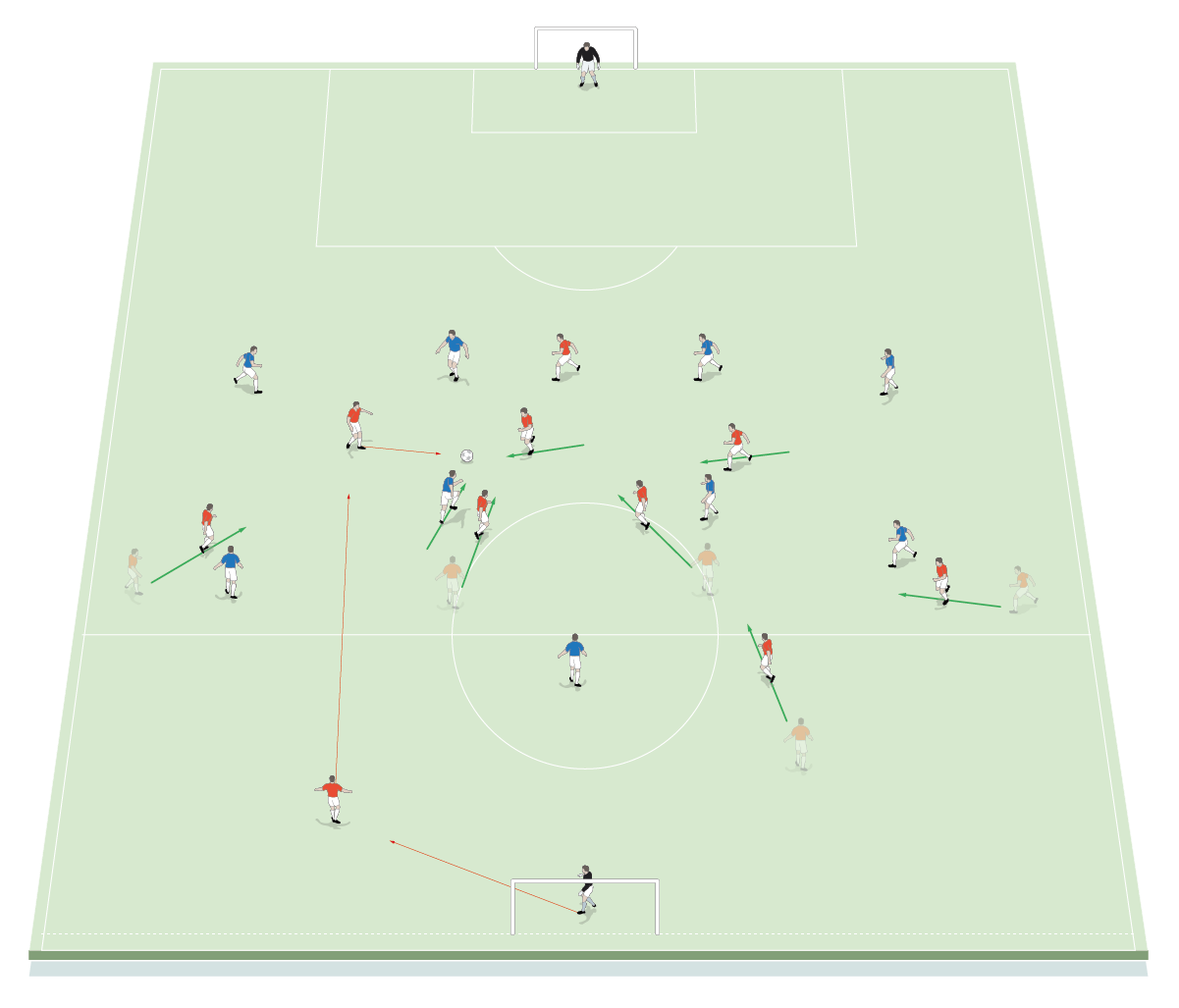
- Play starts with a pass out from the red team’s goalkeeper and the team build play from the back
- The blues immediately press the ball once the red goalkeeper has started play
- The reds should counter-press as soon as possession is lost and should try to win the ball back as quickly as possible
We set up a playing area of 90x75 yards with a goal at each end, as shown. We’re using 19 outfield players and two goalkeepers, split into a red possession team of 11 and a blue pressing team of 10.
Play starts with a pass out from the goalkeeper of the reds and the team must try to build play from the back, as shown [3].
The blues are set up in the formation used by our upcoming opponents and they immediately press the ball once the red goalkeeper has made the first pass. We play a normal game, but the reds must be encouraged to counter-press as a team as soon as possession is lost.
Both teams are on unlimited touches and normal game rules apply, including throw-ins and offsides.
We would change which opposition player to remove from the blue team depending on exactly what we are trying to achieve from a match plan perspective – usually we would remove either a defensive midfielder or a striker.
Editor's Picks
Attacking transitions
Deep runs in the final third
Using the goalkeeper in build-up play
Intensive boxes drill with goals
Penetrating the final third
Creating and finishing
My philosophy
Pressing initiation
Compact team movement
Coaches' Testimonials

Alan Pardew

Arsène Wenger

Brendan Rodgers

Carlos Carvalhal

José Mourinho

Jürgen Klopp

Pep Guardiola

Roy Hodgson

Sir Alex Ferguson

Steven Gerrard
Coaches' Testimonials

Gerald Kearney, Downtown Las Vegas Soccer Club

Paul Butler, Florida, USA

Rick Shields, Springboro, USA

Tony Green, Pierrefonds Titans, Quebec, Canada
Join the world's leading coaches and managers and discover for yourself one of the best kept secrets in coaching. No other training tool on the planet is written or read by the calibre of names you’ll find in Elite Soccer.
In a recent survey 92% of subscribers said Elite Soccer makes them more confident, 89% said it makes them a more effective coach and 91% said it makes them more inspired.
Get Monthly Inspiration
All the latest techniques and approaches
Since 2010 Elite Soccer has given subscribers exclusive insight into the training ground practices of the world’s best coaches. Published in partnership with the League Managers Association we have unparalleled access to the leading lights in the English leagues, as well as a host of international managers.
Elite Soccer exclusively features sessions written by the coaches themselves. There are no observed sessions and no sessions “in the style of”, just first-hand advice delivered direct to you from the coach.









